Home PageAbout MindatThe Mindat ManualHistory of MindatCopyright StatusWho We AreContact UsAdvertise on Mindat
Donate to MindatCorporate SponsorshipSponsor a PageSponsored PagesMindat AdvertisersAdvertise on Mindat
Learning CenterWhat is a mineral?The most common minerals on earthInformation for EducatorsMindat ArticlesThe ElementsThe Rock H. Currier Digital LibraryGeologic Time
Minerals by PropertiesMinerals by ChemistryAdvanced Locality SearchRandom MineralRandom LocalitySearch by minIDLocalities Near MeSearch ArticlesSearch GlossaryMore Search Options
The Mindat ManualAdd a New PhotoRate PhotosLocality Edit ReportCoordinate Completion ReportAdd Glossary Item
Mining CompaniesStatisticsUsersMineral MuseumsClubs & OrganizationsMineral Shows & EventsThe Mindat DirectoryDevice SettingsThe Mineral Quiz
Photo SearchPhoto GalleriesSearch by ColorNew Photos TodayNew Photos YesterdayMembers' Photo GalleriesPast Photo of the Day GalleryPhotography
╳Discussions
💬 Home🔎 Search📅 LatestGroups
EducationOpen discussion area.Fakes & FraudsOpen discussion area.Field CollectingOpen discussion area.FossilsOpen discussion area.Gems and GemologyOpen discussion area.GeneralOpen discussion area.How to ContributeOpen discussion area.Identity HelpOpen discussion area.Improving Mindat.orgOpen discussion area.LocalitiesOpen discussion area.Lost and Stolen SpecimensOpen discussion area.MarketplaceOpen discussion area.MeteoritesOpen discussion area.Mindat ProductsOpen discussion area.Mineral ExchangesOpen discussion area.Mineral PhotographyOpen discussion area.Mineral ShowsOpen discussion area.Mineralogical ClassificationOpen discussion area.Mineralogy CourseOpen discussion area.MineralsOpen discussion area.Minerals and MuseumsOpen discussion area.PhotosOpen discussion area.Techniques for CollectorsOpen discussion area.The Rock H. Currier Digital LibraryOpen discussion area.UV MineralsOpen discussion area.Recent Images in Discussions
Improving Mindat.orghttp://www.mindat.org/photo-153565.html
16th Nov 2014 10:42 UTCVik Vanrusselt Expert
the caption for the image http://www.mindat.org/photo-153565.html
says it's "Shattuckite after Cuprite", while it probably should be "Plancheite after Cuprite" (since it's in the Plancheite gallery for the locality)
Vik
16th Nov 2014 13:36 UTCPaul De Bondt Manager
Thank you for reporting this.
Changed.
Take care and best regards.
Paul.
17th Nov 2014 02:26 UTCRock Currier Expert
17th Nov 2014 17:23 UTCPaul De Bondt Manager
Thank you for the reply.
The fact is that most of the plancheite-shattuckite specimens were identified on sight.
The light colored pieces and plumose varieties were called plancheite and the more solid dark-ones shattuckite.
I am almost sure nobody ever checked this or perhaps in the 50's.
Some even point the fact that shattuckite is extremely rare in Katanga.
I can assure you that the old calcite pseudomorphs are plancheite, see the MR on this subject.
It is true that the recent specimens are different in habit than the old-ones and that they are darker too. But who tested these ?
Katanga did not reveal all his secrets yet.
I hope this helps.
Take care and best regards.
Paul.
18th Nov 2014 22:06 UTCRock Currier Expert
We recently received a shipment of a couple of hundered small plancheite-shattuckite specimens from Katanga. They were all light in color but I had them tested anyway and the x-ray from John Attard came back as shattuckite. There were a number of larger and much fancier specimens of the same material at the recent Denver show in the hands of some of the high end dealers also labeled as shattuckite so that I have reason to believe that other analysis than mine had been done. That is the reason that I suspect that many of the old specimens might not be what they were labeled.




Mindat.org is an outreach project of the Hudson Institute of Mineralogy, a 501(c)(3) not-for-profit organization.
Copyright © mindat.org and the Hudson Institute of Mineralogy 1993-2024, except where stated. Most political location boundaries are © OpenStreetMap contributors. Mindat.org relies on the contributions of thousands of members and supporters. Founded in 2000 by Jolyon Ralph.
Privacy Policy - Terms & Conditions - Contact Us / DMCA issues - Report a bug/vulnerability Current server date and time: April 25, 2024 04:45:27
Copyright © mindat.org and the Hudson Institute of Mineralogy 1993-2024, except where stated. Most political location boundaries are © OpenStreetMap contributors. Mindat.org relies on the contributions of thousands of members and supporters. Founded in 2000 by Jolyon Ralph.
Privacy Policy - Terms & Conditions - Contact Us / DMCA issues - Report a bug/vulnerability Current server date and time: April 25, 2024 04:45:27










